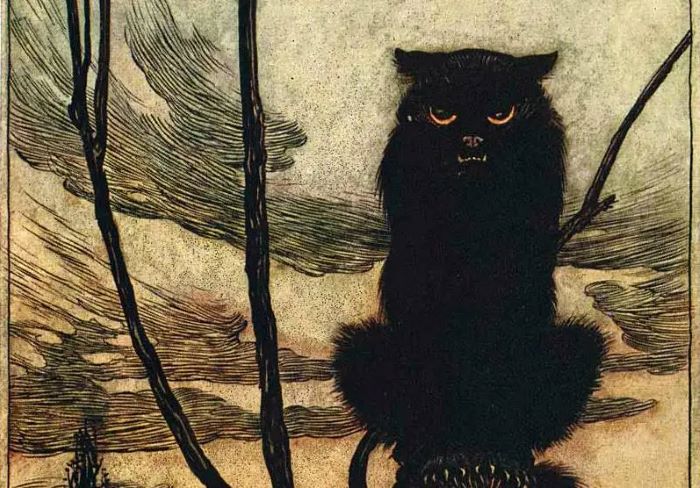Clever and helpful, or devious and downright sneaky, the cats in traditional folk tales have a mixed reputation. The way they are represented reflects how people across generations and in various countries have understood, and frequently misunderstood, the character of the average domestic feline.
The cat-and-mouse theme is especially prevalent and appears in many cultures in old legends and stories that have proved remarkably enduring.
Universal Truths
Early tales about cats appear in the collection of some 200 fables said to have been created by the former Greek slave Aesop (c.620–560BCE). These stories were intended to illustrate universal truths, and the fable of Venus and the Cat makes the point that it is impossible to change one’s true nature.
A cat, desperate to win the affection of a young man, begs Venus, the Greek goddess of love, to change her into a beautiful girl. The wish is granted and a match is made, but after the wedding the bride forgets she is human and pounces on a mouse.
Outraged, Venus changes her back into a cat. The old saying “belling the cat”—taking on a dangerous task—comes from another fable attributed to Aesop, The Mice in Council.
The moral of the tale, as an old mouse points out, is that it is easier to suggest a risky venture than to find someone to carry it out.
Feline Partners
Cats are included in many of the folk tales collected and rewritten by the German scholars and master storytellers Jacob and Wilhelm Grimm at the beginning of the 19th century. In Cat and Mouse in Partnership, the couple of the title set up house together.
The Mouse does the chores, while the greedy Cat devises an elaborate scam that involves eating all their winter provisions. “All gone,” cries the Mouse, suspicions belatedly aroused, before she, too, is gobbled up.
As the story says, “that is the way of the world.” However, the collaboration of cat, donkey, dog, and rooster in another Grimm story, The Musicians of Bremen, is based on mutual respect. Making music with their own voices, the four companions use the combined uproar—as well as claws, teeth, and feet—to scare off a band of robbers and appropriate their comfortable lodgings.
It is not surprising that in so many old stories cats and mice are found together, because until the late 19th century people kept cats primarily for vermin control. In regions as diverse as Europe, Africa, and the Middle East, traditional tales can be found about cats outwitting (and occasionally being outwitted by) mice and rats.
 With his back arched, a cat takes his place among the four friends of the Grimm brothers’ Musicians of Bremen, immortalized in a bronze statue outside Bremen town hall. The landmark by sculptor Gerhard Marcks was installed in 1953.
With his back arched, a cat takes his place among the four friends of the Grimm brothers’ Musicians of Bremen, immortalized in a bronze statue outside Bremen town hall. The landmark by sculptor Gerhard Marcks was installed in 1953.
Fortune Hunters
In fairy tales cats are good at hoodwinking humans, too. The archtrickster has to be the eponymous Puss in Boots. Originally an old French tale (Le Chat Botté) by Charles Perrault, and first published in 1697, Puss in Boots has long been popular as a Christmas pantomime in the UK.
Wily Puss manages to pass off his poverty-stricken master as the noble Marquis of Carabas, who, as penniless nobodies so often do in fairy tales, ends up marrying a king’s daughter. Through association, Puss himself is set up for life.
Another favorite pantomime was created from the tale of Dick Whittington, a real person born in the mid-14th century who was elected Lord Mayor of London several times. There is no record that Whittington had a cat, but in the story, he is accompanied by an intrepid rat-slayer who helps Dick win fame and fortune.
On Highgate Hill in London, the statue of a cat marks the spot where Dick, trudging home defeated in his ambitions, supposedly heard church bells telling him to turn around and try again.
Cat Tales
Some of the most engaging cat legends are interpretations of how and why cats look and behave as they do. The origins of the cat are explained in a tale of Noah’s Ark. When Noah begged God to rid the Ark of multiplying rats, God’s response was to make the lion sneeze—ejecting the very first cat out of its nostrils. In another Ark legend, the Manx cat, arriving late on board, lost its tail as Noah slammed the door shut on it.
A fable from old Siam (now Thailand) tells the story of the Siamese cat’s tail. At one time, many Siamese cats had a distinctive kink in their tail and crossed eyes, traits that were later bred out as undesirable.
According to the story, a Siamese cat guarding a golden goblet for her king clutched the treasure so tightly with her tail and watched it for so long that she developed a kinked tail and a squint.
A traditional Jewish folk tale explains why cats and dogs are age-old enemies. At the beginning of the world, the newly created cat and dog were friends while good times lasted. When winter came, the cat sheltered in Adam’s house, but selfishly refused to share lodgings with the dog. Adam, exasperated by their quarreling, foresaw that cats and dogs would never agree again.


